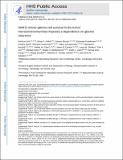| dc.contributor.author | Kami, Kenjiro | |
| dc.contributor.author | Shelton, Laura M. | |
| dc.contributor.author | Ramkissoon, Shakti H. | |
| dc.contributor.author | Ligon, Keith L. | |
| dc.contributor.author | Snuderl, Matija | |
| dc.contributor.author | Kim, Dohoon | |
| dc.contributor.author | Fiske, Brian Prescott | |
| dc.contributor.author | Birsoy, Kivanc | |
| dc.contributor.author | Freinkman, Elizaveta | |
| dc.contributor.author | Possemato, Richard | |
| dc.contributor.author | Chudnovsky, Yakov | |
| dc.contributor.author | Chen, Walter W. | |
| dc.contributor.author | Cantor, Jason R. | |
| dc.contributor.author | Gui, Dan Yi | |
| dc.contributor.author | Kwon, ManJae | |
| dc.contributor.author | Kang, Seong Woo | |
| dc.contributor.author | Vander Heiden, Matthew G. | |
| dc.contributor.author | Sabatini, David | |
| dc.contributor.author | Pacold, Michael Edward | |
| dc.date.accessioned | 2017-01-25T17:35:37Z | |
| dc.date.available | 2017-01-25T17:35:37Z | |
| dc.date.issued | 2015-04 | |
| dc.date.submitted | 2014-03 | |
| dc.identifier.issn | 0028-0836 | |
| dc.identifier.issn | 1476-4687 | |
| dc.identifier.uri | http://hdl.handle.net/1721.1/106619 | |
| dc.description.abstract | Cancer cells adapt their metabolic processes to support rapid proliferation, but less is known about how cancer cells alter metabolism to promote cell survival in a poorly vascularized tumour microenvironment1, 2, 3. Here we identify a key role for serine and glycine metabolism in the survival of brain cancer cells within the ischaemic zones of gliomas. In human glioblastoma multiforme, mitochondrial serine hydroxymethyltransferase (SHMT2) and glycine decarboxylase (GLDC) are highly expressed in the pseudopalisading cells that surround necrotic foci. We find that SHMT2 activity limits that of pyruvate kinase (PKM2) and reduces oxygen consumption, eliciting a metabolic state that confers a profound survival advantage to cells in poorly vascularized tumour regions. GLDC inhibition impairs cells with high SHMT2 levels as the excess glycine not metabolized by GLDC can be converted to the toxic molecules aminoacetone and methylglyoxal. Thus, SHMT2 is required for cancer cells to adapt to the tumour environment, but also renders these cells sensitive to glycine cleavage system inhibition. | en_US |
| dc.description.sponsorship | American Brain Tumor Association (Basic Research Fellowship) | en_US |
| dc.description.sponsorship | Massachusetts Institute of Technology. School of Science (Fellowship in Cancer Research) | en_US |
| dc.description.sponsorship | Jane Coffin Childs Memorial Fund for Medical Research (Fellowship) | en_US |
| dc.description.sponsorship | Leukemia & Lymphoma Society of America (Fellowship) | en_US |
| dc.description.sponsorship | National Institutes of Health (U.S.) (Grants T32GM007287, K99 CA168940, R01CA168653, 5P30CA14051, CA103866, CA129105, and AI07389) | en_US |
| dc.description.sponsorship | American Cancer Society (Fellowship) | en_US |
| dc.description.sponsorship | American Brain Tumor Association (Discovery Grant) | en_US |
| dc.description.sponsorship | National Institute on Aging (Fellowship) | en_US |
| dc.description.sponsorship | Smith Family Foundation | en_US |
| dc.description.sponsorship | Burroughs Wellcome Fund | en_US |
| dc.description.sponsorship | Damon Runyon Cancer Research Foundation | en_US |
| dc.description.sponsorship | Stern Family | en_US |
| dc.description.sponsorship | United States. Dept. of Defense. Congressionally Directed Medical Research Programs (Discovery Award) | en_US |
| dc.description.sponsorship | David H. Koch Institute for Integrative Cancer Research at MIT | en_US |
| dc.description.sponsorship | Alexander and Margaret Stewart Trust | en_US |
| dc.language.iso | en_US | |
| dc.publisher | Nature Publishing Group | en_US |
| dc.relation.isversionof | http://dx.doi.org/10.1038/nature14363 | en_US |
| dc.rights | Article is made available in accordance with the publisher's policy and may be subject to US copyright law. Please refer to the publisher's site for terms of use. | en_US |
| dc.source | PMC | en_US |
| dc.title | SHMT2 drives glioma cell survival in ischaemia but imposes a dependence on glycine clearance | en_US |
| dc.type | Article | en_US |
| dc.identifier.citation | Kim, Dohoon et al. “SHMT2 Drives Glioma Cell Survival in Ischaemia but Imposes a Dependence on Glycine Clearance.” Nature 520.7547 (2015): 363–367. | en_US |
| dc.contributor.department | Harvard University--MIT Division of Health Sciences and Technology | en_US |
| dc.contributor.department | Massachusetts Institute of Technology. Department of Biology | en_US |
| dc.contributor.department | Whitehead Institute for Biomedical Research | en_US |
| dc.contributor.department | Koch Institute for Integrative Cancer Research at MIT | en_US |
| dc.contributor.mitauthor | Kim, Dohoon | |
| dc.contributor.mitauthor | Fiske, Brian Prescott | |
| dc.contributor.mitauthor | Birsoy, Kivanc | |
| dc.contributor.mitauthor | Freinkman, Elizaveta | |
| dc.contributor.mitauthor | Possemato, Richard | |
| dc.contributor.mitauthor | Chudnovsky, Yakov | |
| dc.contributor.mitauthor | Pacold, Michael E | |
| dc.contributor.mitauthor | Chen, Walter W. | |
| dc.contributor.mitauthor | Cantor, Jason R. | |
| dc.contributor.mitauthor | Gui, Dan Yi | |
| dc.contributor.mitauthor | Kwon, ManJae | |
| dc.contributor.mitauthor | Kang, Seong Woo | |
| dc.contributor.mitauthor | Vander Heiden, Matthew G. | |
| dc.contributor.mitauthor | Sabatini, David | |
| dc.relation.journal | Nature | en_US |
| dc.eprint.version | Author's final manuscript | en_US |
| dc.type.uri | http://purl.org/eprint/type/JournalArticle | en_US |
| eprint.status | http://purl.org/eprint/status/PeerReviewed | en_US |
| dspace.orderedauthors | Kim, Dohoon; Fiske, Brian P.; Birsoy, Kivanc; Freinkman, Elizaveta; Kami, Kenjiro; Possemato, Richard L.; Chudnovsky, Yakov; Pacold, Michael E.; Chen, Walter W.; Cantor, Jason R.; Shelton, Laura M.; Gui, Dan Y.; Kwon, Manjae; Ramkissoon, Shakti H.; Ligon, Keith L.; Kang, Seong Woo; Snuderl, Matija; Vander Heiden, Matthew G.; Sabatini, David M. | en_US |
| dspace.embargo.terms | N | en_US |
| dc.identifier.orcid | https://orcid.org/0000-0002-2401-0030 | |
| dc.identifier.orcid | https://orcid.org/0000-0003-3688-2378 | |
| dc.identifier.orcid | https://orcid.org/0000-0002-7043-5013 | |
| dc.identifier.orcid | https://orcid.org/0000-0003-0130-3428 | |
| dc.identifier.orcid | https://orcid.org/0000-0002-6702-4192 | |
| dc.identifier.orcid | https://orcid.org/0000-0002-1446-7256 | |
| mit.license | PUBLISHER_POLICY | en_US |
| mit.metadata.status | Complete | |
